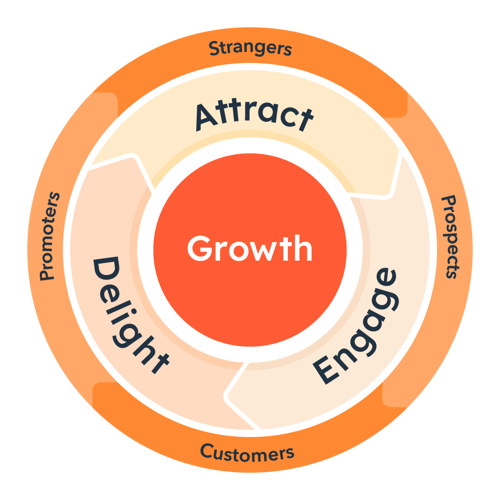What is inbound marketing?
Inbound marketing is a methodology to attract loyal customers to your business by aligning with your target audience's needs. Creating tailored marketing experiences through valuable content is the core of an inbound marketing strategy that helps you drive customer engagement and growth.
Inbound Marketing Overview
The inbound methodology is the strategic method of growing your organization by building meaningful, lasting relationships with consumers, prospects, and customers as opposed to interrupting them with traditional advertising methods. It’s about valuing and empowering these people to reach their goals at any stage in their journey with you.
Why? Because when your customers succeed, you succeed.
The inbound methodology can be applied in three ways:
- Attract: drawing in the right people with valuable content and conversations that set you up as a trusted advisor.
- Engage: presenting insights and solutions that align with their pain points and goals so they are more likely to buy from you.
- Delight: offering help and support to empower your customers to find success with your product.
Why is inbound marketing important?
When customers find success and share that success with others, it attracts new prospects to your organization, creating a self-sustaining loop. This is how your organization builds momentum, and this is why the inbound methodology serves as a strong foundation for your flywheel.

To reach and engage with that target audience effectively, you need to shift your business focus toward inbound marketing strategies. From HubSpot Co-Founder Brian Halligan’s perspective, "[If] you create all this content, and it's rich content — it's informative, it [will] pull people in…so people fall in love with your brand." By using social media, email marketing, blogging, and a truly exceptional website, you can create valuable, informative, and engaging content that pulls people in and cultivates a genuine connection with your brand. Embracing the inbound methodology serves as a strong foundation for building momentum to attract new prospects and ultimately drive business growth.
How does inbound marketing work?
Inbound marketing strategies will help you effectively market to your target audience the inbound way. Keep your flywheel spinning and help your business grow better.
Attracting Strategies
Inbound marketing strategies that attract your target audience and customer personas are tied to content creation and development.
To reach your audience, start by creating and publishing content — such as blog articles, content offers, and social media — that offers value. Examples include guides on how to use your products, information about how your solution can solve their challenges, customer testimonials, and details about promotions or discounts.
To attract your audience members on a deeper level through inbound marketing, optimize all this content with an SEO strategy. Target specific keywords and phrases related to your products or services, the challenges you solve for customers, and the ways you help customers.
This SEO strategy will allow your content and information to organically appear on the search engine results page (SERP) when people search for this information. These folks are your target audience, and likely the right customers for your business.
Engaging Strategies
When using inbound strategies to engage your audience, make sure you’re communicating and dealing with leads and customers in a way that makes them want to build long-term relationships with you. When using these engagement strategies, inject information about the value your business will give them.
Specific engagement strategies may include how you handle and manage your inbound sales calls. Focus on how customer service representatives handle calls from interested people and prospects. Additionally, be sure you’re always solution selling rather than product selling. This will make sure all deals end in mutually beneficial agreements for customers and your business — meaning, you offer value for your right-fit customers.
Delighting Strategies
Inbound strategies that delight make sure customers are happy, satisfied, and supported long after they buy. These strategies involve your team members becoming advisors and experts who can assist customers at any time.
Incorporating thoughtful, well-timed chatbots and surveys to help, support, and request feedback is a great way to delight your customers. Bots and surveys should be shared at specific points throughout the customer’s journey to make sure they are relevant and valuable.
For example, chatbots may help current customers set up a new technique or tactic you've started offering that they’d like to take advantage of. Additionally, a satisfaction survey may be sent out six months after customers buy your product or service to get their feedback and review ideas for improvement.
Social media listening is another important strategy when it comes to delighting customers. Social media followers may use one of your profiles to give feedback, ask questions, or share their experience with your products or services. Show that you hear and care by responding to these interactions with information that helps, supports, and encourages followers.
Lastly, the mark of an inbound strategy focused on delighting customers is one that helps and supports customers in any situation, whether your business gets any value out of it or not. Remember, a delighted customer becomes a brand advocate and promoter, so handle all interactions, both big and small, with care.
Get Started With Your Inbound Marketing Strategy
As an inbound marketer, your goal is to attract new prospects to your company, engage with them at scale, and delight them individually.
You also partner with your sales and services teams to keep the flywheel spinning effectively and help the business grow. It's a big job, but the inbound methodology and Marketing Hub have you covered.

| Attract Tools | Engage Tools | Delight Tools |
| Ads Video Blogging Social media Content strategy |
Lead flows Email marketing Lead management Conversational bots Marketing automation |
Smart content Email marketing Conversations inbox Attribution reporting Marketing automation |
Attract
You don’t want just anyone coming to your website. You want people who are most likely to become leads and, ultimately, happy customers. How do you get them there? You attract more of the right customers with relevant content at the right time.
Use the content strategy tool to build your authority in search and rank for the topics that matter the most to your prospects. Publish your blog post or video content across social networks using social media tools. Create ads to increase awareness of your brand with your target audience. Throughout each stage, reporting and analytics will help you know what’s working and where you need to improve.
Engage
Use HubSpot Conversations to create lasting relationships with prospects on the channels they prefer — through email, bots, live chat, or messaging apps. Use conversion tools like — CTAs, forms, and lead flows — to capture the information of prospects visiting your site.
Use all the prospect and customer information in the CRM to personalize the website experience using smart content, and the entire buyer’s journey using email and workflows. Create brand loyalty by targeting specific audiences with your social content or ads. Connect your favorite tools to HubSpot to fit the unique needs of your business.
Delight
Use email and marketing automation in conjunction with HubSpot Conversations to deliver the right information to the right person at the right time, every time. Use the Conversations inbox to align with your sales and service team members to create contextual conversations with the people you do business with. Create memorable content your prospects can share with their friends and family by using a variety of content formats that your prospects prefer, like video,.
By combining the inbound methodology with HubSpot software, you’ll grow your business and get customers to buy more, stay with you longer, refer their friends, and tell the world they love you.
Learn Inbound Marketing
Sign up for a free HubSpot Academy course to learn inbound marketing, access free tools to try inbound yourself, and get certified. Grow your business and your career with the inbound methodology.
